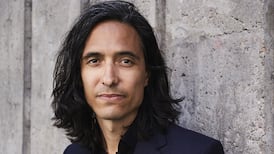The Life and Work of Richard King: Religion, Nationalism and Modernism was published in January as part of Peter Lang’s Reimagining Ireland series, the culmination of my research on the artist over 30 years.
My first encounter with King’s art came when I was invited by the Capuchin community in Church Street, Dublin, in September 1989, to provide a catalogue raisonné of the artist’s religious paintings from 1946 to 1972. These works, originally reproduced as illustrations for The Capuchin Annual, located at the time in the Capuchin Friary, Church Street, are now in the Irish Capuchin Provincial Archives, Church Street, Dublin. I completed this two-volume catalogue entitled The Paintings of Richard King for The Capuchin Annual in July 1992.
In September 1999, I commenced a thesis on King under the direction of Dr Paula Murphy (now Professor Emerita), of the School of Art History and Cultural Policy, University College Dublin. This thesis, entitled The Religious Art of Richard King in Ireland: 1933-73, which has formed the basis of the published book, was awarded an MLitt in March 2007.
I hoped eventually to publish my findings as a monograph on the artist because my research proved to me that King had and still has not received the recognition he deserves as a religious artist or as a talented stained glass artist. When I read the description of Peter Lang’s Reimagining Ireland series, outlining how it seeks to examine changing definitions of Irishness in the realm of spirituality, theology, the visual arts, culture, history and nationalism, I sensed that a book on Richard King would be an appropriate edition. I was, therefore, delighted when my proposal for a book on the artist was accepted in June 2016 by the general editor, Dr Eamon Maher, and I set about writing it accordingly.
The book, as indicated by its title, focuses on the central themes of King’s life and career, which are religion, nationalism and modernism. The scope of the book is thus broader than the original thesis, in its inclusion of more of King’s secular art and a greater emphasis on his work overseas.
Given that the artist was a profoundly spiritual person, religion and the Christian faith in particular were the over-riding concerns of both his art and personal disposition. The evolution of his work in stained glass, religious illustrations for The Capuchin Annual and Stations of the Cross in different media, reveals changes in theology and spirituality in pre-and post-Vatican II Ireland. Thus my study of King’s oeuvre has been interdisciplinary in its examination of the relationship between religion and art in Ireland from the 1930s to early 1970s.
King’s training as a stained glass artist under Harry Clarke (1889-1931) from 1928-30 was pivotal for his development and skills in this medium. The apprenticeship under Clarke informed King’s knowledge of religious symbolism, strong design, decoration inspired by the Celtic Revival and jewel-like colour, with much emphasis on blue glass.
These aspects are especially evident in the early stained glass windows designed by him while in the Harry Clarke Stained Glass Studios from 1928-40. In particular, the integrity of Clarke’s interpretation of religious subject matter was of crucial significance for his followers. An early work by King, the lovely, moving, single-light stained glass window of St Elizabeth of Hungary (1934) in the chapel of the Sacred Heart Convent, Mount Anville, Dundrum, Dublin, testifies in its design, colour and symbolism to the powerful influence of Harry Clarke on his art in the 1930s.
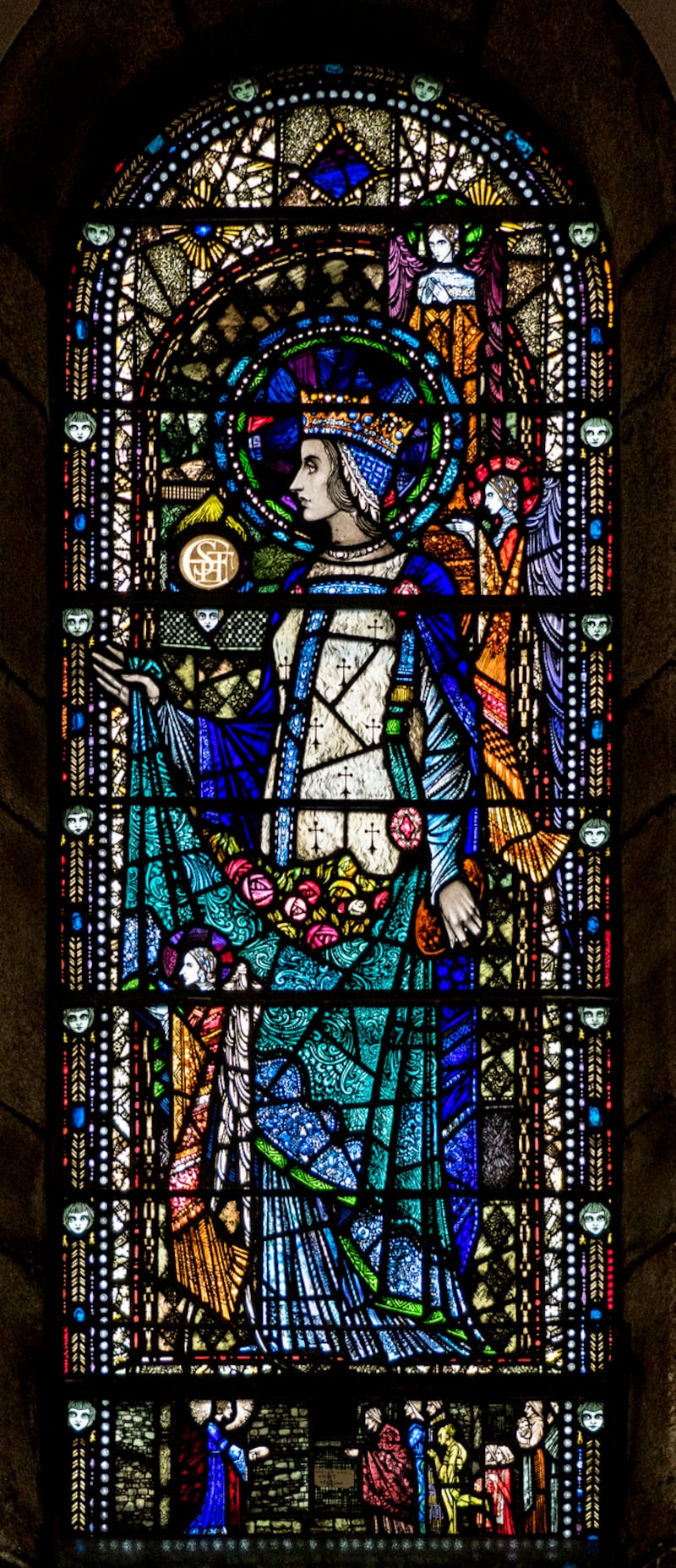
King was profoundly Irish and Ireland was very important to him. Born in Castlebar, Co Mayo, on July 7th, 1907, he was a man of the west. His appreciation of the light and beauty of the west of Ireland was shown in landscapes painted in oils and watercolours in Galway and Mayo during the 1930s and 40s.
Hence other dominant themes prevalent in King’s early work of this period are nationalism and definitions of Irishness as seen by his images of Éire, always portrayed as a woman. King was, in fact, quite political and was interested in Irish history, culture and patriotism. These elements were visible in his secular work such as the black and white illustrations of Celtic myths in scraperboard for The Capuchin Annual and The Father Mathew Record during the 1930s and ’40s.
The artist’s most significant secular and nationalistic work of this period is The Kevin Barry Memorial Window (1932-34), in the Charles Institute of Dermatology, University College, Belfield, Dublin. Like the St Elizabeth of Hungary window, this beautiful stained glass window in eight panels also profoundly reflects the influence of Harry Clarke.
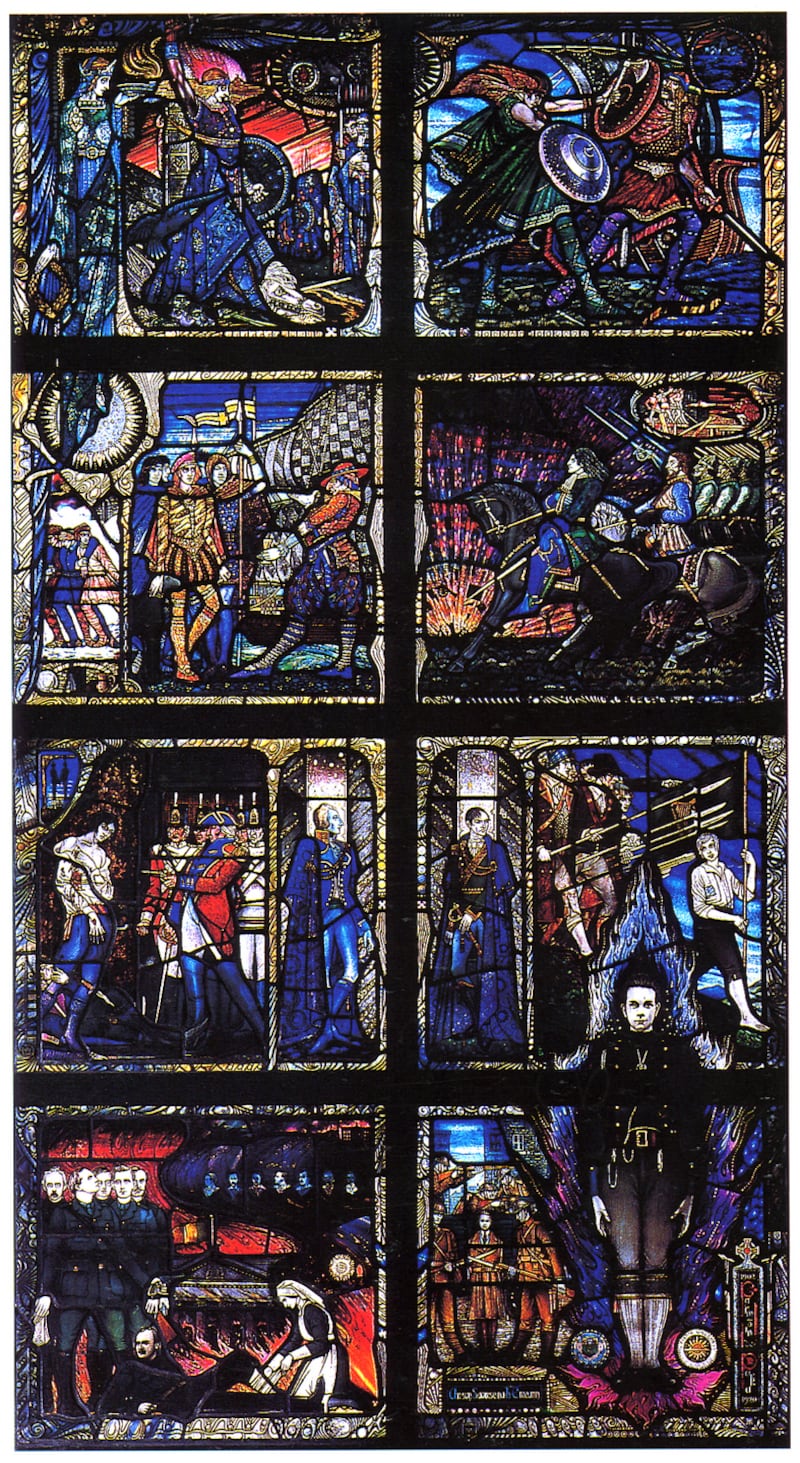
The work is, in effect, a metaphor for Ireland, with images in the panels, which depict the sacrifices involved in the struggle for Irish freedom and independence. This is especially indicated by the symbolical connection between the prominent female Éire figure on the top left and the large figure of Kevin Barry on the bottom right. As an interpretation of Ireland which is traditional, but also imaginative, romantic and visionary, this stained glass window, distinguished by rich colour and decoration inspired by the Celtic Revival, is an iconic work of Irish art of its time.
The artist’s stunning stamp designs of the 1930s and ’40s, which were both secular and religious in subject matter, also focus on Irishness, informed by nationalism, religion and the Celtic Revival, as can be seen in the St Patrick and The Constitution stamps both of 1937. Apart from his work in stained glass windows and his black and white illustrations in scraperboard, his stamps in particular reveal that King is a very accomplished designer.
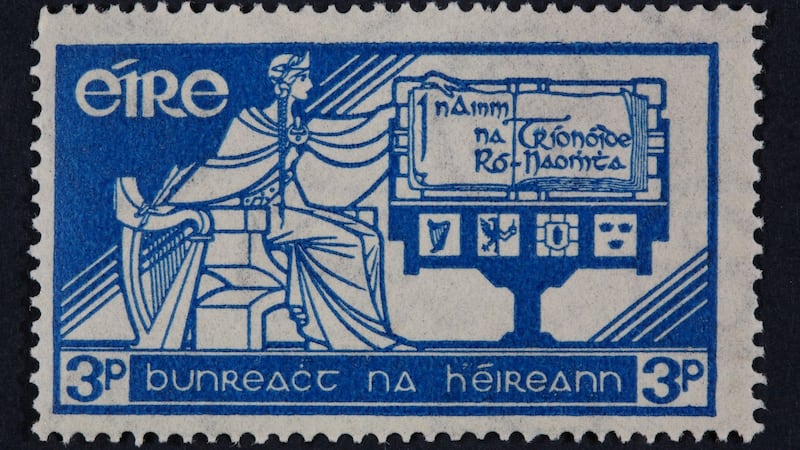
The artist left the Harry Clarke Studios in May 1940 to establish his own independent career. Although the residual legacy of the Harry Clarke style remained in his work until the 1940s, King gradually moved away from this in order to develop his own artistic identity during the years 1948-60. Hence the other central theme in the book, which is modernism, deals with this period in King’s career when he experimented frequently in both style and technique.
His interests in modernism made him increasingly aware of the work of British and European artists in France and Germany. His constant experimentation produced many changes and variation in quality in his work during the 1950s and ’60s. The depiction of themes of traditional Christian iconography in a modernist style occasionally caused some unevenness in his oeuvre during this time.
After Harry Clarke, the French artist Georges Rouault (1871-1958), whose religious art and images of Christ in particular were notable for their modernist, authentic, unconventional and existential qualities, was the next most significant influence on King’s development. During the 1950s and early to mid 1960s, the artist’s work became very eclectic with many changes in style.
Although always figurative at this stage, King’s art displayed the influences of expressionism, cubism and abstraction, as revealed by his painting of An abstraction of the Crucifixion (1964) in oils on canvas in the Church of St Agnes, Crumlin, Dublin.
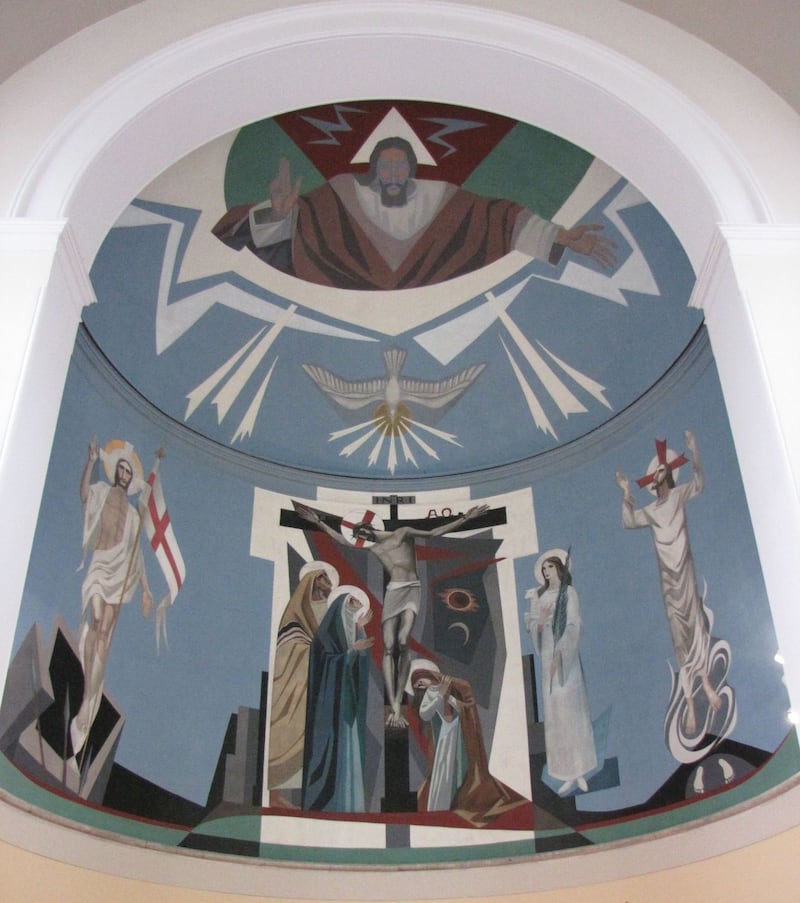
King knew the work of Mainie Jellett (1897-1944), whose paintings of religious themes also combined some of these stylistic characteristics. Other Irish artists who contributed to the modernist elements in King’s stained glass and religious illustrations for The Capuchin Annual during the 1950s and ’60s are Evie Hone (1894-1955) and Wilhelmina Geddes (1887-1955).
King’s experimentation with technique led him to work in vitreous and non-vitreous enamels from the early 1960s to early 1970s. As this medium was vitreous like stained glass, it suited his style and expression very well. The Second Station of the Cross Jesus is Given His Cross to Bear (1964-67) in non-vitreous enamels on copper in the Church of Our Lady and St Nicholas, Dunmore, Co Galway, is restricted to a half-length view of the isolated figure of Christ, whose face, in profile, demonstrates the influence of Rouault and involves the viewer in a meditative experience of the Passion. These Stations are also distinguished by expressive, contrasting colour, combined with cubist shapes.

However, by the mid to late 1960s, the consistent eclecticism and experimentation had eventually run its course. This enabled King, having absorbed many different influences, to finally find his own style and his authentic voice as a religious and stained glass artist which were ultimately distinctive and unique to him.
Alongside the benefits of modernism for King’s evolution as an artist were significant theological developments which allowed him to grow at the spiritual level. The updating of the Catholic Church which came with Vatican II had an impact on King’s theological outlook.
The liturgical changes brought about by the Council allowed religious artists more freedom in the treatment of religious subjects. In particular, the salient themes of the Council Documents such as Christ crucified and risen, the Holy Spirit, the Eucharist, the Trinity, Revelation, Eschatology and a new approach to Mariology, had a bearing on King’s interpretation of religious themes during this period.
Moreover, the artist’s study of the theological writings of French palaeontologist, philosopher and theologian Pierre Teilhard de Chardin SJ (1881-1955) in the late 1950s and again in the 1960s deepened his theological understanding and enabled him to have a more intellectual approach to matters of Christian faith. Hence King’s interest in the crucified/risen Christ and cosmic Christ in the universe was the source for hope, radiance, luminosity and the presence of the divine as significant dimensions of his late work.
His stained glass windows in Ireland and overseas, his Stations of the Cross in enamels and his religious illustrations for The Capuchin Annual during the late 1960s and early 1970s, are thus imbued with the uncreated light of God.
Richard King’s career proves that despite his talents in a variety of media, his work in stained glass provided the best outlet and vehicle for his gifts. His artistic evolution also points to all the inherent problems associated with images of religious art and the importance of depicting such subjects in a manner which is not pious, nor sentimental, but sincere and which addresses both the emotions and the intellect.
Hence King’s return to the authentic sources with symbols drawn from Early Christianity combined with abstraction is exemplified by his late stained glass windows in the chapel of Dominican Convent, Wicklow (1966-67) and those in the chapel of Nazareth House, Dublin (1969-70). In the latter chapel, The Fish (Christ) stained glass window (1969-70), the large fish symbolises the crucified and risen Christ through contrasts of light and darkness with the Greek letters in the centre foreground meaning Jesus Christ, Son of God, Saviour.
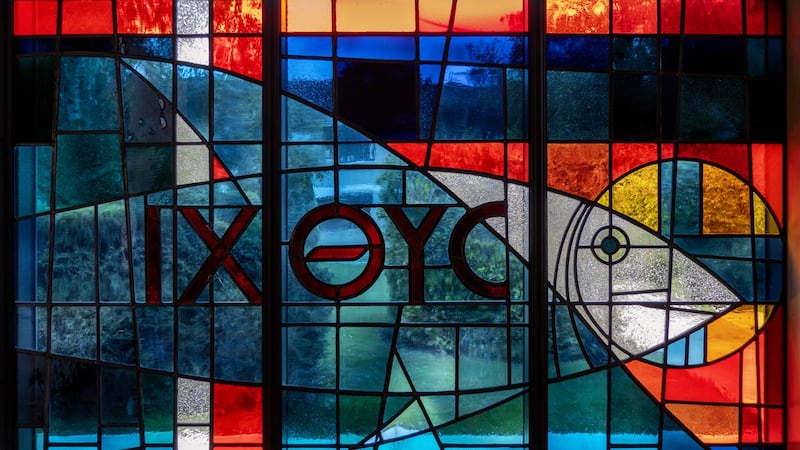
The concept of God as mystery, communicated through symbol and an abstract style, produces an effect which is both meditative and stimulating. This late stained glass window, distinguished by austere lines and shapes, testifies to the influence of the modern German stained glass artist Anton Wendling (1891-1965).
Richard King, who died on March 17th, 1974, aged only 66, following an illness, had achieved a huge amount and had a phenomenal output in his career as an artist both in Ireland and overseas.
Researching and writing about Richard King’s work for my MLitt thesis and the published book has allowed me as an art historian to document his artistic and spiritual journeys, as both were closely intertwined. I hope that this book will bring King the recognition which he rightly deserves for his contribution to religious art and stained glass in Ireland and abroad.
During his lifetime, while he had a good career with commissions in Ireland and overseas, such appreciation often eluded him. His religious illustrations for The Capuchin Annual resulted in his art being viewed as traditional and not modernist. This publicaton will, I hope, rectify these matters and set the record straight.
Despite the variability of his work in mid-career, to which I have alluded, Richard King has not been sufficiently rated as an artist, especially in the medium of stained glass and religious art. This book reveals the importance of Ireland and nationalism to him, his engagement with modernism and the originality of his theological vision and insight.
Ruth Sheehy is a librarian in the department of the history of art and architecture at Trinity College Dublin. Her book The Life and Work of Richard King: Religion, Nationalism and Modernism was nominated for the Michel Déon nonfiction prize 2020, which is organised by the Royal Irish Academy


